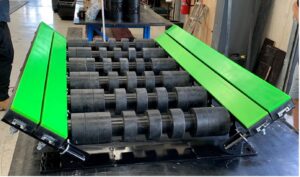3 Types of Conveyor Belt Joins
Conveyor belts are commonly used in various industries for the transportation of goods, materials, and products. The process of joining or repairing conveyor belts often involves methods like cold splicing, hot splicing, or using mechanical belt fasteners or clips. We will explore each of these methods separately.
Hot Splicing:
Process: Hot splicing involves the use of heat to melt or vulcanize a special rubber material to achieve the splice, which is effectively joining the ends of conveyor belts. Where possible, Conveyor Belts Australia seeks to undertake a hot splice. This type of join creates a quality join that is virtually unbreakable. Moreover, the belt can typically be used far more rapidly than other methods. Hot splicing can be challenging on mobile equipment (crushers, screeners etc). At Conveyor Belts Australia, we’ve developed methods for achieving a hot splice on a range of common mobile equipment found in the Australian quarry and mining industries. If you are looking for this type of splice, its worth chatting to our team.
Advantages: Hot splicing results in the strongest and most durable connection between the ends of the belt. The process allows the belt to be used with minimal downtime.
Disadvantages: A good splice requires a good team. Many belt teams cannot achieve a hot splice on difficult belts.
Cold Splicing:
Process: Cold splicing is a method of joining conveyor belts without the need for heat. It typically involves the use of a cold adhesive or cement to bond the two belt ends together. This type of splice can produce a very durable join, but often requires a longer period of time for the cement to harden before the belt can be utilised.
Advantages: Cold splicing is often considered convenient and many belt teams can undertake this type of join.
Disadvantages: Longer down time required for the belt to be joined safely. The splice is typically strong but not as strong as a hot splice method.
Clips or Mechanical Fasteners:
Process: Mechanical fasteners, such as clips, are metal pieces that are attached to the ends of the conveyor belts. They are typically installed by fastening the clips to the belt ends using bolts or rivets. This kind of method can often be achieved locally by untrained crews. The actual installation of the clips should be completed by a qualified belt team, but the belt can then be installed with limited instructions by the local workforce.
Advantages: Mechanical fasteners are quick to install and do not require special skills or equipment. They are often used in applications where its difficult to get a qualified team out. They can also be used for repairs or pre-prepared belts.
Disadvantages: Some clips are prohibitively expensive. Other clips are much cheaper but can be difficult to install or maintain. Overall clips are convenient but are only a substitute for the above methods described.
Considerations:
The choice between cold splicing, hot splicing, or mechanical fasteners depends on factors such as the application, conveyor belt type, material being transported, and the required strength of the splice. It will often hinge on the quality of advice and service available from your local belt team.
If you want advice on what options work best for you and your site, give our team a call. We maintain a 24/7 breakdown and advice service to make sure you can get up a running again quickly if you have a belt failure. We stock a wide range of belts and can conduct all methods of belt joining.






